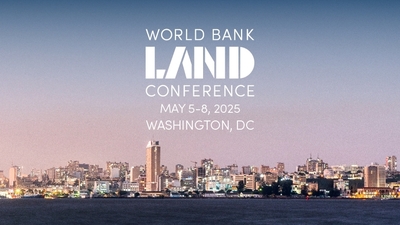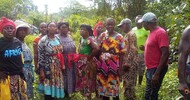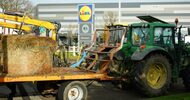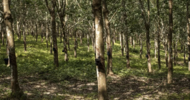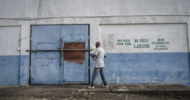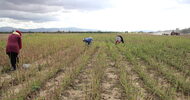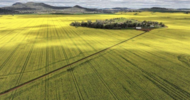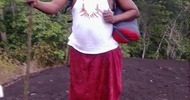Hedge funds and bankers are buying everything from farmland to mines across the Global South. Mark L Thomas looks at how speculators here fuel exploitation half a world away
A single commodity trader in London hit the headlines this month when he snapped up 7 percent of the world’s entire cocoa bean production.
His actions drove the price to its highest level in more than three decades. But Anthony Ward – or “Chocfinger” as he has been dubbed in the press – is far from alone.
Just two years on from the economic crash, the speculators who caused it are back – rescued from oblivion by state bank bailouts.
With slim pickings in housing markets, this time hedge funds and bankers are betting on everything from farmland to minerals across the Global South.
Sharmila Naik lives in Advalpal, in the Indian state of Goa. He tells of what it’s like to be at the sharp end of the mining speculators.
“Companies came to our village, offered money and mines got started,” he says.
“However after one year we realised how dangerous this mining was. We started opposing the mines.
“Mines disrupted water flow in the village and our crop got flooded at the time of harvest. The mine buried existing water lakes with mining silt.
Village
“Further mining even dug our crematorium space, where our village used to cremate the dead.
“In June last year our village got flooded due to mining. Mining silt was deposited into the houses of the people.
“It was very traumatic moment for my family and villagers. A few houses got badly hit by the floods.
“Mining has also destroyed cashew crops. We used to get bumper crops every year but for the past few years not only has the yield deteriorated, but also the places where cashew trees grow have been used for mining.
“Now my family is forced to move out of Advalpal as there are no sources of living left in the village.”
Following the financial trail back from Advalpal shows how the process works.
The mines are owned by Sesa Goa, a major Indian producer of iron ore.
It made £180 million between April and June this year – a threefold increase from a year earlier.
Sesa Goa, in turn, is owned by one of Britain and India’s richest men – Anil Agarwal.
And it gets much of its funding from Hermitage Capital, based in Mayfair.
Bill Browder, the head of Hermitage, says he fears that governments in the West will deal with the huge bank bailout debts by printing money, instead of taking on the working class and forcing through cuts.
Bowder and his friends are worried this would devalue any financial investments wealthy investors own. So Hermitage is turning to betting on “hard assets” like commodities and land to make money.
Hermitage’s “Global Fund”, which manages £650 million for the rich, is pushing its money into gold and mining companies.
In the 1990s the company made money investing in the newly opened up markets of Russia. Hermitage’s London officers have a modest exterior. But it is rumoured that the interior is modelled on the St Petersburg palace in Russia that it shares a name with.
In Advalpal people are paying the price – but also fighting back. “In May 2008 there was a major revolt in our village against mining,” says Sharmila.
“We marched on the mine site and stopped the work by force. But the mining companies got police protection and carried on their operations.
“Few people of our village who own trucks benefit from the mining industry. The rest of us get no benefit at all.
“Our village is losing terribly and I feel it has to stop – once and for all.”
The robber barons behind Mayfair’s closed doors
A small name tag next to a buzzer in Mayfair, London, hides the offices of one of the richest and most brutal companies in the world.
The building houses the offices of the European arm of Paulson & Co – the world’s second largest hedge fund.
Behind this and many more of Mayfair’s closed doors are rich “robber barons”, making vast profits by looting the world.
John Paulson made billions betting that the US “sub-prime” mortgage market would collapse. As it imploded, he personally pocketed £2.3 billion in 2007 alone.
Now the 45th richest person in the world with an estimated £12 billion fortune, Paulson is buying up gold and the mining companies that dig it out.
Paulson & Co bought a £831 million stake in the South African gold mining company AngloGold Ashanti last year.
Paulson now owns more gold than Australia. Yet his company is just one small part of the “shadow banking system” lurking in Mayfair.
Commodity
The area is also home to huge commodity trading firms like Glencore – described as “the king of commodities” by the Financial Times.
Last year Glencore made profits of £1.8 billion.
This highly secretive company publishes no public accounts – but its tentacles spread across the globe.
It trades in everything from natural gas to zinc, sugar, wheat and copper. It owns mines, oil fields and farmland.
Glencore invests heavily in Katanga Mining, a company that has been making huge profits in the Democratic Republic of Congo by asset stripping.
Congo has the world’s largest reserves of cobalt (used in everything from jet engines to batteries) and 4 percent of the world’s copper reserves.
These resources, were nationalised as state mining company Gécamines when Congo won its independence, after years of plunder by Belgium colonialism.
But now Congo has been robbed again – by mining multinationals.
Katanga Mining has a joint contract with Gécamines to mine copper and cobalt at Kolwezi, in the country’s Katanga province.
But the contract gives 75 percent ownership – and profits – to the firm and just 25 percent to Gécamines.
This is costing the state at least £97 million a year – more than a fifth of the government’s annual revenues.
But despite these massive profits, as soon as the cash starts to dry up the hedge funds cut and run.
A few months after the start of the economic crisis in 2008, 41 of the 75 metals processing companies in Katanga stopped production. Around 300,000 mining jobs disappeared.
In response the government turned to the International Monetary Fund for a loan – and stepped up repression against workers.
At Katanga Mining’s copper and cobalt mine, police teargassed 500 workers who were facing the sack in April last year.
‘Designed to loot shipwrecks’ Hedge funds are private investment companies that bet on the movement of shares, debts, commodities, currencies – anything that they think will rake in a profit. “Hedge funds were designed to loot shipwrecks,” is how Karl Miller, senior partner at bankers Miller, McConville, Christen, Hutchison & Waffel, puts it. You won’t find them on the high street, because unlike the main banks and building societies, they are exclusively tailored to the rich. Originally they offered themselves to the very wealthy, but as profits flooded in, other investment companies and pension funds joined in. Hedge funds have vast financial power – there are around 8,000 hedge funds controlling assets worth £1.8 trillion.Farmland: ‘gold with a cash flow’
Farmland in some of the poorest countries in the world is being bought up by hedge funds as they once again bet on rising food prices.
The World Bank and the United Nations Food and Agriculture Organisation say there has been a “sharp increase” in agricultural land investments across the globe.
Farmland is attractive because it is seen as a safe asset, but also generates income.
As one US hedge fund manager puts it, “farmland is gold with a cash flow”.
A London-based investment fund, Altima Partners LLP, has ploughed about £650 million into farming-related investment and is planning a new agricultural fund this year.
Ethiopia alone has seen 815 foreign-financed agricultural projects since 2007.
The food grown on the purchased farmland will be sold for lucrative exports, making it even harder to feed local people.
Almost half of the population of Ethiopia is already undernourished.
In Mozambique, the London-based Central African Mining and Exploration Company has bought 30,000 hectares of land to grow biofuels for export.
The project will divert water from a dam which is currently used by small farmers. The same land had been previously promised to over 1,000 families who lost their land when a national park was created.
Many will now end up joining the billion people in the world who already don’t have enough to eat, while the rich who created the crisis continue to make a profit.
Coming for you next Asset stripping isn’t just limited to the Global South. Two of the biggest asset strippers are Blackstone and Carlyle – two more companies with offices in Mayfair. They are looking to move into education and healthcare in Europe, in anticipation of more privatisation opening up lucrative investment opportunities. A fifth of private equity deals in Europe so far this year have been in healthcare companies. Mark L Thomas went on a tour of Mayfair with the London Mining Network. For more information visit: www.londonminingnetwork.org, www.minesandcommunities.org and www.farmlandgrab.org


